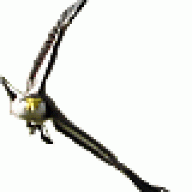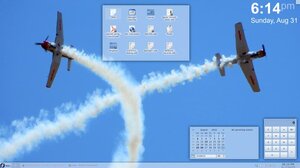-
Posts
13 -
Joined
-
Last visited
Powerin's Achievements
Newbie (1/14)
0
Reputation
-
Most fish are pretty tolerant of copper, but it is deadly to invertebrates such as crayfish (yabbies), shrimp and snails if you happen to keep them with your fish. Yabbies can be an entertaining addition to an aquarium.
-
OK FD...this may be a "weird" reply but you asked for it. The basic fact you need to know is that your fish is swimming around in his own toilet. The "critters" on your gravel or in your filter are aerobic bacteria and they do exactly the same as they do in a sewage treatment plant. They convert highly toxic ammonia from the fish waste into less toxic nitrates. Fish can handle a certain amount of nitrates but there are limits. In a closed system like a fish tank the nitrates will gradually build up, there is nowhere for them to go. The fish will tolerate it up to a certain point but will not be healthy and will soon die. Some fish like the Fighting fish can tolerate it more than others bet eventually it will get em. The solution is to occasionally flush the toilet.....but gradually. The best thing you can do for your fish is to take a quarter of the water (and with it the toxins) out at least every couple weeks and replace it with fresh water. pH and other stuff can be an issue too....but nitrate is the number one health problem and killer. Don't forget about toxic chlorine as mentioned above. The golden rule - fish in an aquarium are swimming in their own toilet...flush it now and then.
-
From what I've heard the margin on fuel for servos is a lot less than 10c. I am led to believe most servos make very little on fuel...in many cases it is a loss leader to bring customers into their convenience/food store.
-
No worries OME, no offence taken. Harvest time, with long days driving in the heat (our trucks aren't air conditioned), makes one a bit over-sensitive at that hour of the night. My apologies for over-reacting as well.
-
I will admit however that fuel is an essential commodity and people will tend to pay whatever it costs. The city fuel price cycle is a strange thing. With food, another essential thing, the price is often more stable. There is a price point which people are willing to pay for, say, red meat. You will find this is what supermarkets and butchers charge for meat, regardless of what the price of cattle or lamb is in the wholesale market. If farmers are getting cheap prices the supermarkets make a big profit, if we are getting good prices the supermarkets make very little. If the price of red meat is too high consumers will easily turn to chicken or some other food so the price stays relatively stable.
-
With respect......if you buy fuel randomly throughout the year, you too are averaging the cost of fuel. But, if you are smart, you can enjoy the wonders of market speculation and take advantage of one of the most predictable price cycles that occur in the world. Do you really think that because we pay an "average" price that it is actually stable and predictable? The TGP has moved by 3 cents in the last few days! You city dwellers have the advantage of incredible price wars that us country folk can never take advantage of. I would have paid 135.09c on Monday for ULP. Thanks also for the remark that we are all tax cheats. Yes, the majority of our fuel (diesel) is a business expense and we claim around 90% because that is what we use for our business. All I was trying to say is that prices are a volatile thing. You city folk have the advantage of a TGP price indicator that tells you if the bowser price is cheap or not. If it's cheap buy it! There and then. In the next hour it might change. In the farming world if Vladimir Putin says something about troops in Ukraine (Ukraine being a major world wheat grower) it can mean $1000s out of (or into) a farming family's pocket from the price speculations on the world wheat market.
-
Supply and demand Daz...unfortunately, and perhaps some cross subsidizing as well. World demand for diesel will affect the price regardless of refining costs. Plus diesel doesn't seem to go through the same cycles as unleaded. Sorry to bring in another farming analogy...there are several qualities of wheat from the top quality high protein wheat used for bread, down to the low quality stuff used for animal feed. There can be a 25% or more difference in price. Quality usually depends on the weather for the year. If we all have a good year and all produce top quality wheat the price will often plummet (depending on world prices). At the same time there will be a shortage of stock feed grains and the price of feed wheat and all feed grains (like barley) will go up so that the crap wheat is nearly worth as much as top quality wheat. Supply and demand. The saddest part of this scenario is the high price of feed barley might also put an upward price pressure on malting barley used for beer! So the price of beer might be because wheat farmers grew too much high quality wheat!
-
The petrol price cycle is certainly a mysterious Australian phenomena. I buy fuel in bulk and it tends to be priced to the average...neither high nor low. But really, you guys should be taking advantage of price cycles. At the low end of the cycle the fuel companies are selling at a loss...so why not do your research, fill up then and screw them that way? On Monday the Terminal Gate Price (the wholesale price the service stations buy it at) in Sydney for ULP was about 128c/lt. So if the pump price is down around this level then they are selling at a loss. It won't go lower than the TGP, so keep an eye on that and you know when the bottom of the cycle is coming..... http://www.aip.com.au/pricing/tgp.htm The price of canola dropped by nearly $20/tonne the other day. So a semi load of my canola is suddenly worth $500 less than it was. Have a little think about that next time you lose a few bucks when the price of fuel goes up
-
Ah well.....thread drift to desktops..here's mine [ATTACH]47450._xfImport[/ATTACH] Fedora 20 with a KDE desktop
-
Or for a simpler explanation see Kev's post above....which is about what I said but far more concise! Heat the water, change the water, keep it stable. They often live in puddles so are pretty tolerant of other conditions
-
Hi FD, Siamese fighting fish (or Bettas) are a native of Thailand (obviously from the name) and as such are a tropical fish, so firstly they need a fairly stable temperature (despite what you may have been told) and an aquarium heater would be a good investment. The acidity of the water should be around pH 7 (ie neutral) for most Asian tropical fish.....but it varies from species to species depending on the environment they come from. It's been a while since I kept fish but I used a simple pH test kit with a little test tube to sample the water and you add a few drops of an indicator fluid which changed colour according to pH. You compare the colour of the test tube to a colour chart. This only takes seconds and is cheap and reliable. You can spend heaps more on electronic meters...but really pH is only a part of the equation. The main thing is to avoid big changes in water quality/temp. Keep things stable and make changes gradually. Chucking a heap of Sodium Bicarbonate in would not be very good, even if you are trying to correct bad water quality. Bicarb is a good buffer which helps stabilise pH, but too much can also send the water pH too high....and your water may already have enough hardness that will already keep the pH stable. Fighting fish do have the capability of taking a gulp of air to supplement the oxygen in the water as they are often found in small pools and puddles in Thailand with low oxygen. Because of this they are reasonably tolerant of bad water conditions. But if you want your fish to have a long life it's best to ensure good oxygen in the water. Bubbles don't actually add much oxygen to an aquarium. It mainly comes from the surface of the water interacting with air. Bubbles will help remove carbon dioxide from the water though, and help circulate the water. By the way, your filter is "aerobic" (requiring oxygen), not anaerobic. The job of your aquarium filter is to establish and maintain a colony of aerobic bacteria which will convert deadly ammonia from fish waste and respiration into less harmful nitrates. This is the same process that sewage plants use to treat sewage. And this leads into the golden rule of keeping fish. You need to regularly change the water to avoid a build up of nitrates which will kill the fish eventually. 25% every week or two is a good rule of thumb. If you don't change water a fish will eventually choke in it's own waste...a filter will only help for so long. Finally, remember that chlorine in city drinking water is deadly to fish. Always use a chlorine neutraliser. Sometimes pet stores don't always tell you all this info because they quite like selling fish to replace ones that die As you can see, successful fish keeping is a BIG subject. Reading a lot is a good idea if you want to keep fish alive.
-
FD, we've had only digital for a couple years. Ours are on Hi VHF frequencies (channels 7-12) and I think Sydney's are too. I didn't need to upgrade anything and I have splitters, an amplifier (which I probably don't need any more) and 20 year old coax. We are not in a strong signal area. You should have no trouble at all if you currently receive your analogue channels OK. However, digital is pretty sensitive to electrical interference so your mileage may vary. If your building antenna system ends up to be inadequate surely you will have enough angry tenants that the landlord will upgrade. Failing that, and if you are even just a little bit handy, try building one of these antennas - http://www.tvantennaplans.com/ I built one out of farm fencing wire (similar to wire coathanger), some wood and screws and a balun from Jaycar. I didn't worry about the reflector part. I couldn't be bothered crawling in the ceiling to connect our main antenna to my son's room so tried this one just in case it worked. I just used a bit of coax I had hanging around to connect it up, nothing special. It's mounted on the roof gutter. Believe it or not it works great...and our TV towers are about 100km away.
-
Hmmm, 27.7. More than three times more likeable than Tomo . Pete reigns supreme though.



